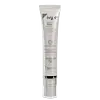What's inside
What's inside
 Key Ingredients
Key Ingredients

 Benefits
Benefits

 Concerns
Concerns

 Ingredients Side-by-side
Ingredients Side-by-side

Cyclopentasiloxane
EmollientWater
Skin ConditioningIsostearyl Palmitate
EmollientPolyethylene
AbrasiveButylene Glycol
HumectantPolysilicone-11
Ethylene/Acrylic Acid Copolymer
Emulsion StabilisingMorus Bombycis Root Extract
Skin ConditioningCaffeine
Skin ConditioningPhytosphingosine
Skin ConditioningTriticum Vulgare Bran Extract
Skin ConditioningScutellaria Baicalensis Root Extract
AstringentLactis Proteinum
Skin ConditioningOlea Europaea Fruit Extract
BleachingCamellia Sinensis Leaf Extract
AntimicrobialCholesterol
EmollientLinoleic Acid
CleansingTocopheryl Acetate
AntioxidantMagnesium Ascorbyl Phosphate
AntioxidantPyridoxine Dipalmitate
Skin ConditioningSucrose
HumectantGlycerin
HumectantDimethicone
EmollientGlyceryl Laurate
EmollientPEG/PPG-18/18 Dimethicone
EmulsifyingPetrolatum
EmollientCetyl PEG/PPG-10/1 Dimethicone
EmulsifyingPropylene Carbonate
SolventSodium Chloride
MaskingQuaternium-90 Bentonite
Disodium EDTA
Phenoxyethanol
PreservativeIron Oxides
Cyclopentasiloxane, Water, Isostearyl Palmitate, Polyethylene, Butylene Glycol, Polysilicone-11, Ethylene/Acrylic Acid Copolymer, Morus Bombycis Root Extract, Caffeine, Phytosphingosine, Triticum Vulgare Bran Extract, Scutellaria Baicalensis Root Extract, Lactis Proteinum, Olea Europaea Fruit Extract, Camellia Sinensis Leaf Extract, Cholesterol, Linoleic Acid, Tocopheryl Acetate, Magnesium Ascorbyl Phosphate, Pyridoxine Dipalmitate, Sucrose, Glycerin, Dimethicone, Glyceryl Laurate, PEG/PPG-18/18 Dimethicone, Petrolatum, Cetyl PEG/PPG-10/1 Dimethicone, Propylene Carbonate, Sodium Chloride, Quaternium-90 Bentonite, Disodium EDTA, Phenoxyethanol, Iron Oxides
Butylene Glycol
HumectantMagnesium Ascorbyl Phosphate
AntioxidantAtelocollagen
Skin ConditioningSodium Chondroitin Sulfate
Skin ConditioningXanthan Gum
EmulsifyingPolysorbate 20
EmulsifyingSodium Acrylates Copolymer
Hydrogenated Polyisobutene
EmollientPhospholipids
Skin ConditioningPolyglyceryl-10 Stearate
Skin ConditioningHelianthus Annuus Seed Oil
EmollientDimethicone
EmollientCyclopentasiloxane
EmollientDimethicone Crosspolymer
Emulsion StabilisingGlycine
BufferingHesperidin Methyl Chalcone
AntioxidantSteareth-20
CleansingDipeptide-2
Skin ConditioningPalmitoyl Tetrapeptide-7
Skin ConditioningHyaluronic Acid
HumectantSilanetriol
Caprylyl Glycol
EmollientPhenoxyethanol
PreservativeBehenyl Alcohol
EmollientGlyceryl Stearate
EmollientLecithin
EmollientGlycine Soja Sterols
EmollientMica
Cosmetic ColorantTitanium Dioxide
Cosmetic ColorantPsidium Guajava Fruit Extract
AstringentVitis Vinifera Fruit Extract
Skin ConditioningTriticum Vulgare Sprout Extract
Skin ConditioningDisodium EDTA
Parfum
MaskingWater
Skin ConditioningButylene Glycol, Magnesium Ascorbyl Phosphate, Atelocollagen, Sodium Chondroitin Sulfate, Xanthan Gum, Polysorbate 20, Sodium Acrylates Copolymer, Hydrogenated Polyisobutene, Phospholipids, Polyglyceryl-10 Stearate, Helianthus Annuus Seed Oil, Dimethicone, Cyclopentasiloxane, Dimethicone Crosspolymer, Glycine, Hesperidin Methyl Chalcone, Steareth-20, Dipeptide-2, Palmitoyl Tetrapeptide-7, Hyaluronic Acid, Silanetriol, Caprylyl Glycol, Phenoxyethanol, Behenyl Alcohol, Glyceryl Stearate, Lecithin, Glycine Soja Sterols, Mica, Titanium Dioxide, Psidium Guajava Fruit Extract, Vitis Vinifera Fruit Extract, Triticum Vulgare Sprout Extract, Disodium EDTA, Parfum, Water
 Reviews
Reviews

Ingredients Explained
These ingredients are found in both products.
Ingredients higher up in an ingredient list are typically present in a larger amount.
Butylene Glycol (or BG) is used within cosmetic products for a few different reasons:
Overall, Butylene Glycol is a safe and well-rounded ingredient that works well with other ingredients.
Though this ingredient works well with most skin types, some people with sensitive skin may experience a reaction such as allergic rashes, closed comedones, or itchiness.
Learn more about Butylene GlycolCyclopentasiloxane, or D5, is a silicone used to improve texture of products and trap moisture.
D5 is considered lightweight and volatile. Volatile means it evaporates quickly after application. Once evaporated, D5 leaves a thin barrier that helps keep skin hydrated.
It is also an emollient. Emollients help soften the skin and prevent water loss. Silicones create a silky texture in products. D5 helps other ingredients become more spreadable.
Studies show D5 is safe to use in skincare products. We recommend speaking with a skincare professional if you have concerns.
Learn more about CyclopentasiloxaneDimethicone is a type of synthetic silicone created from natural materials such as quartz.
What it does:
Dimethicone comes in different viscosities:
Depending on the viscosity, dimethicone has different properties.
Ingredients lists don't always show which type is used, so we recommend reaching out to the brand if you have questions about the viscosity.
This ingredient is unlikely to cause irritation because it does not get absorbed into skin. However, people with silicone allergies should be careful about using this ingredient.
Note: Dimethicone may contribute to pilling. This is because it is not oil or water soluble, so pilling may occur when layered with products. When mixed with heavy oils in a formula, the outcome is also quite greasy.
Learn more about DimethiconeDisodium EDTA plays a role in making products more stable by aiding other preservatives.
It is a chelating agent, meaning it neutralizes metal ions that may be found in a product.
Disodium EDTA is a salt of edetic acid and is found to be safe in cosmetic ingredients.
Learn more about Disodium EDTAMagnesium Ascorbyl Phosphate (MAP) is a form of Vitamin C and is an antioxidant. It can help to reduce redness, improve skin texture, reduce the effects of aging, reduce the visibility of dark spots, and brighten skin.
MAP is created by combining ascorbic acid with magnesium salt. While MAP more gentle on the skin than ascorbic acid, it is thought to be less easily-absorbed into the skin.
Due to MAP's stability up to a pH level of 7, it is more stable to air and sunlight exposure than ascorbic acid. The best pH range for MAP is between 5 and 6.
Like other forms of Vitamin C, MAP has been shown to help reduce hyperpigmentation and simulate collagen production.
As an antioxidant, it helps protect your skin against the signs of aging.
Learn more about Magnesium Ascorbyl PhosphatePhenoxyethanol is a preservative that has germicide, antimicrobial, and aromatic properties. Studies show that phenoxyethanol can prevent microbial growth. By itself, it has a scent that is similar to that of a rose.
It's often used in formulations along with Caprylyl Glycol to preserve the shelf life of products.
Water. It's the most common cosmetic ingredient of all. You'll usually see it at the top of ingredient lists, meaning that it makes up the largest part of the product.
So why is it so popular? Water most often acts as a solvent - this means that it helps dissolve other ingredients into the formulation.
You'll also recognize water as that liquid we all need to stay alive. If you see this, drink a glass of water. Stay hydrated!
Learn more about Water